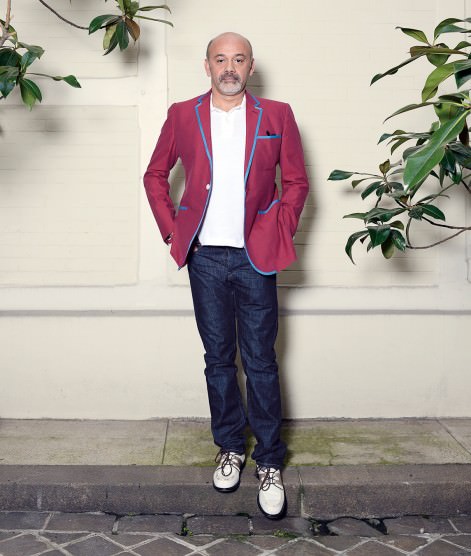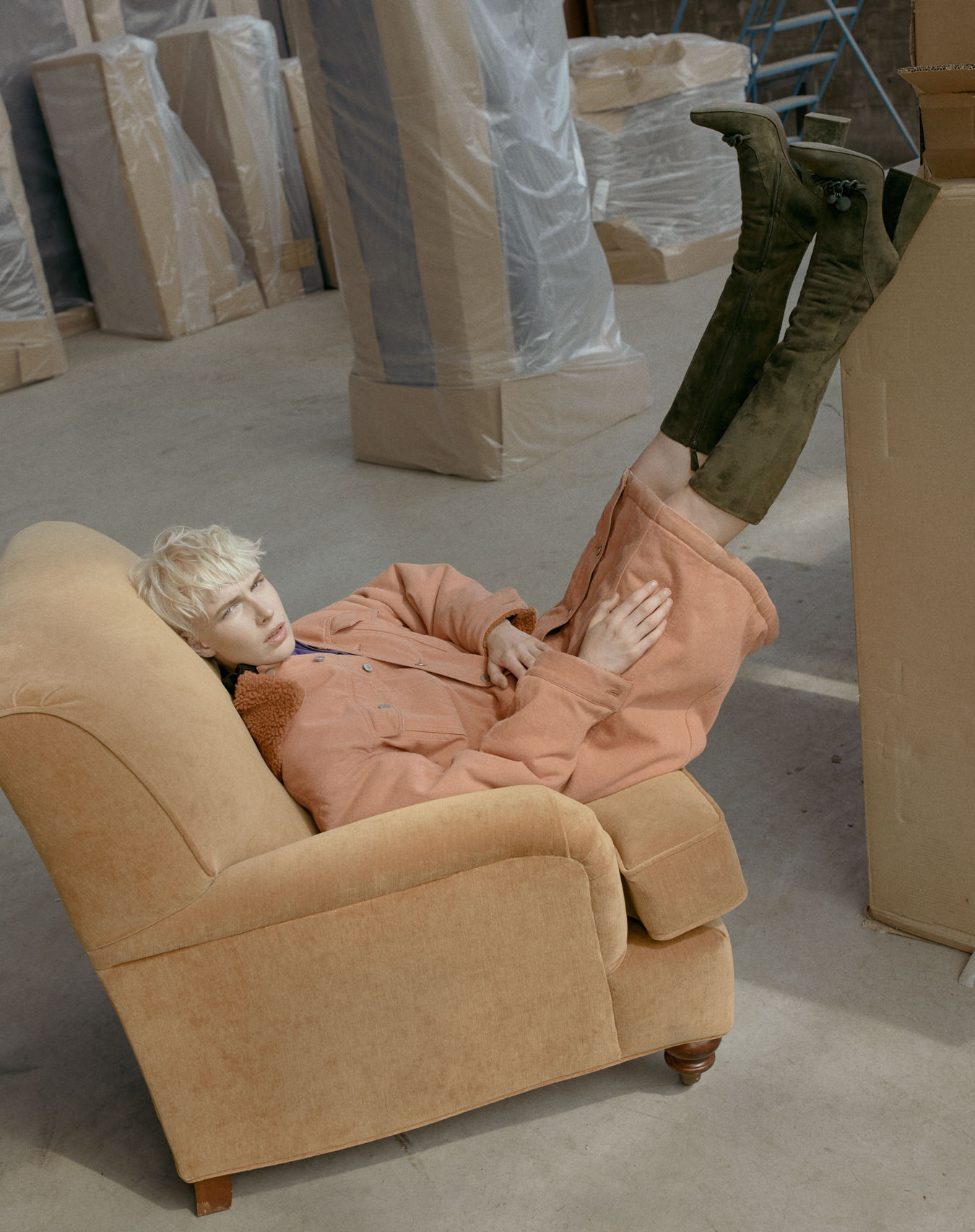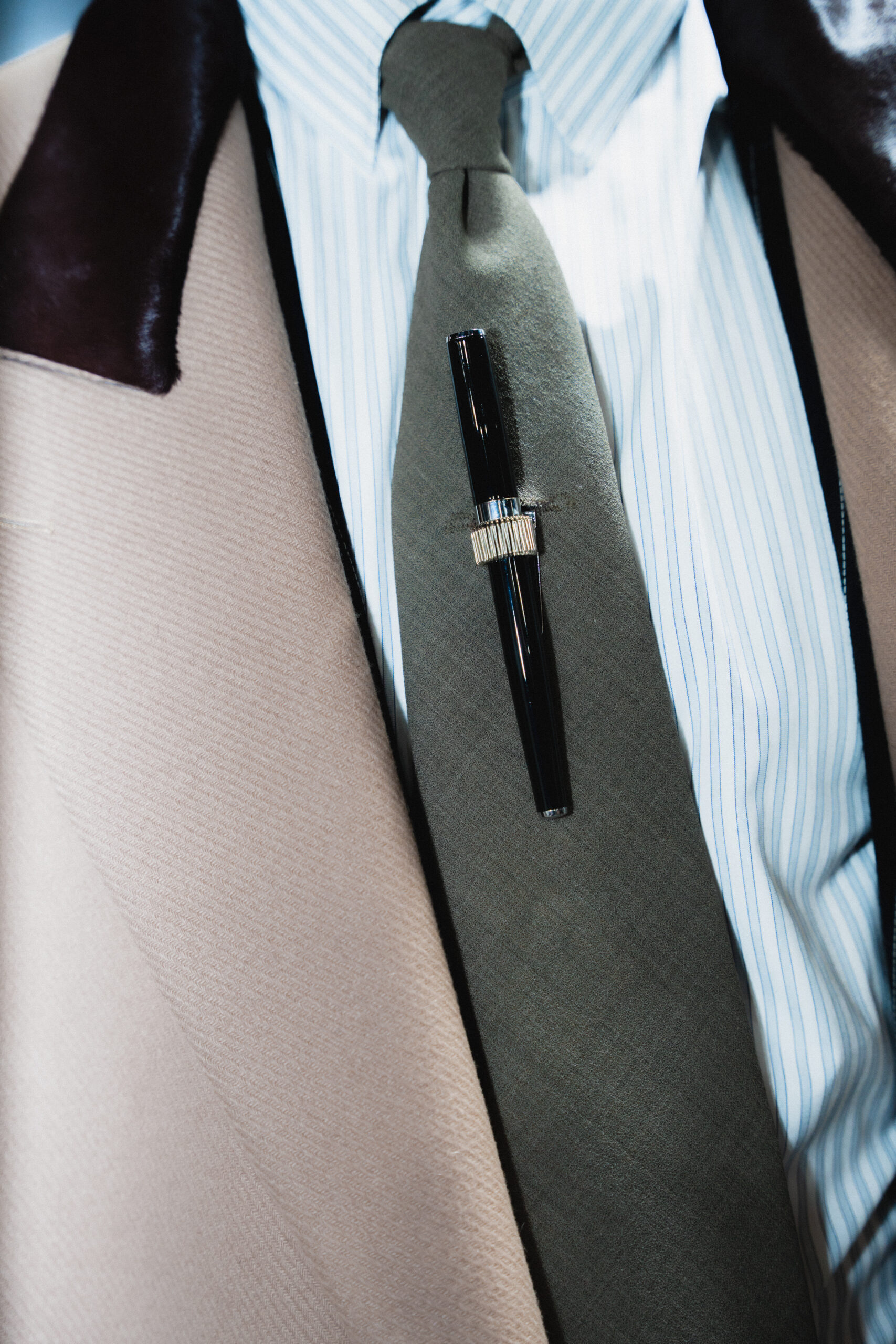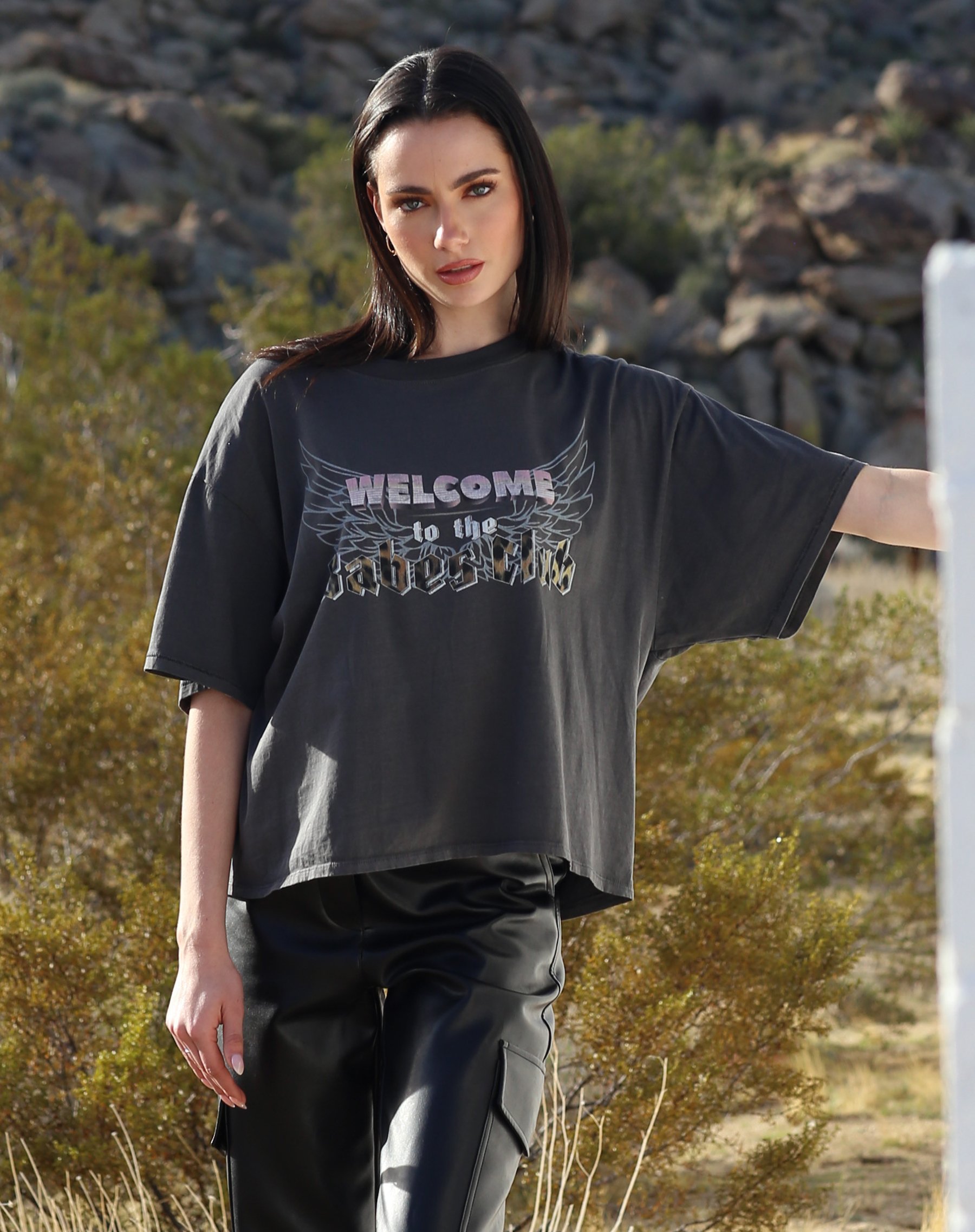Christian Louboutin
Creative sole.
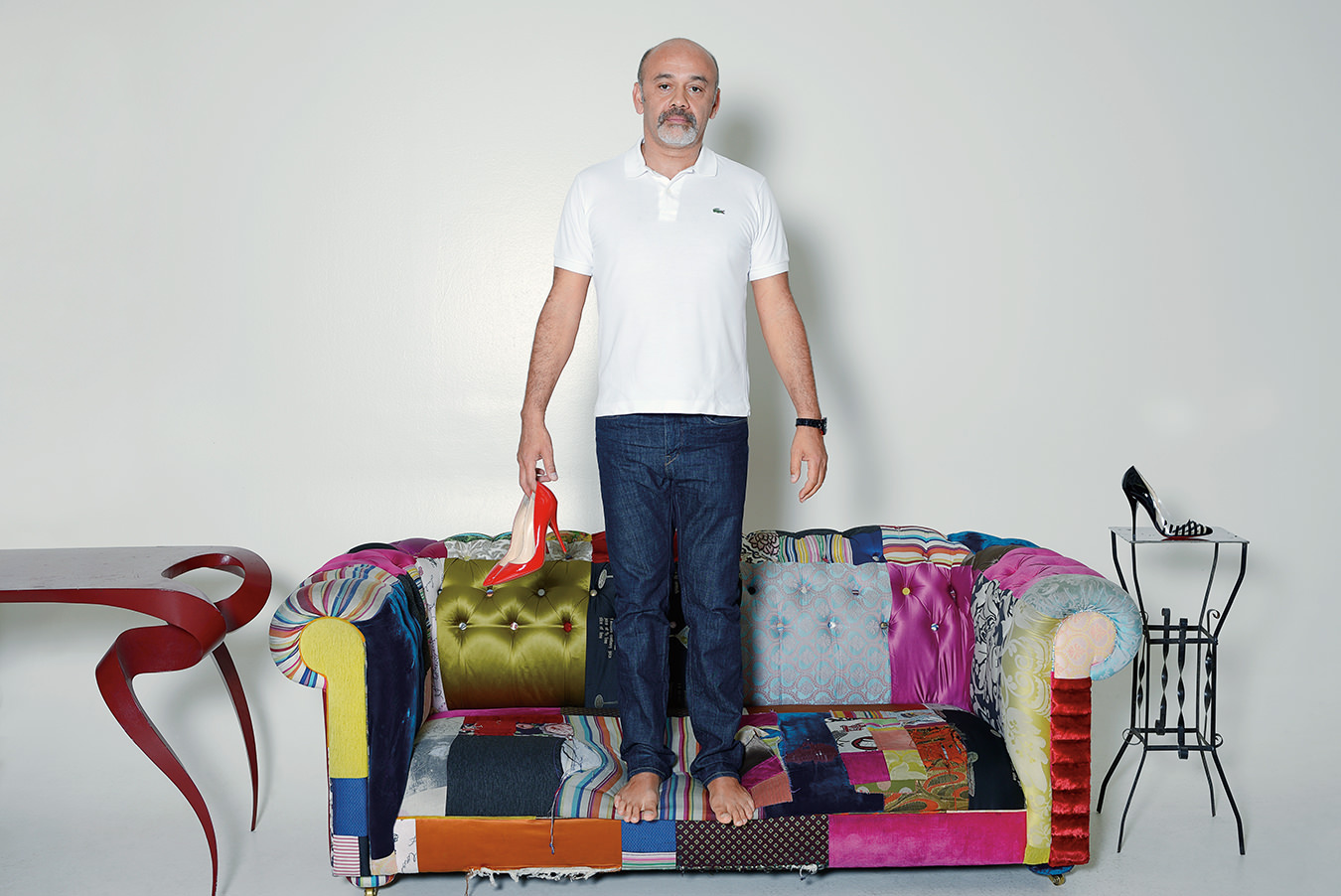
Photo by Olivier Amsellem.
“Some of my shoes over the years might have a different line or arch of the heel, but they’re clearly all connected,” says Christian Louboutin, summing up the design DNA that has developed over the 22 years since he first opened his boutique on rue Jean-Jacques Rousseau in Paris, just down the street from the atelier.
He ticks off a list of hallmarks: “Toe cleavage, high and skinny heels, embellishment, wood and other kinds of handicraft, mixing materials, embroidery, details. Always.” The only thing he neglects to mention is his lipstick-red lacquer sole, rendered since 1992 in Pantone’s 18-1663 TPX colour—though perhaps to do so would be pushing the obvious, which is unlikely for a man whose manner is as restrained as his creative output is over the top.
In the quarter century since Louboutin emerged onto the fashion map, he has changed here and there: though in great shape physically, he’s a bit stockier in build and a bit thinner up top, as often happens when a man reaches the age of 50, which he did this January. But if Louboutin’s aesthetic obsessions have remained as consistent as the schoolboy blazers he’s sported since he was a fixture at Paris’s Palace nightclub in the eighties, it’s only recently—coinciding with his company’s 20th anniversary in 2011—that he has been in much of a mood to take it all in and give the rest of us the chance to see for ourselves. This look back has come in the form of an eponymous coffee-table book published by Rizzoli and a travelling exhibition that debuted at London’s Design Museum last year, arriving at Toronto’s Design Exchange (DX) this June.
A few years ago, Louboutin—whose shoes have been red-carpet fixtures for more than a decade, which inspired a fan-girl tribute song by his faithful client Jennifer Lopez—didn’t even keep proper archives. “I’m sentimental,” he says matter-of-factly, “but not nostalgic.” It wasn’t the anniversary that compelled him to catalogue but a chance conversation over dinner with his friend Hamish Bowles, the international editor-at-large for American Vogue. “He asked me where I was storing shoes from older collections,” Louboutin recalls. “I told him they were in the basement, and not to worry, that I packed them nicely. He said he wanted to see them, so I said okay, fine, and we went down there after dinner. Well, we discovered that there had just been a flood, and there was at least a foot of standing water everywhere. I took the first box I could find, opened it, and the shoes were completely rotten. Hamish started to scream, and said, ‘You have to understand that these designs might all come from you, but at some point they belong to the history of fashion. This isn’t fair!’” Louboutin is laughing now, and he adds, “I didn’t even save my sketches until one of my employees started to do it for me.”
The keepers of fashion history have done good work with the material Louboutin has given them, and now they’ve got a hit on their hands: the Christian Louboutin exhibition in London was so popular that it broke 20 years of Design Museum attendance records. The museum ended up extending its opening hours to accommodate demand, and many of the showgoers wore their Louboutins in tribute. “People are very familiar with Christian’s shoes,” says Donna Loveday, the London exhibition’s curator, “but they know very little about him as a designer.”
Christian Louboutin will be on exhibit at the DX from June 21 to September 15. “Louboutin is iconic for a reason,” says Shauna Levy, president of the Design Exchange. “When people think about his footwear, they’re excited by it. There’s an element of surprise and magic and theatre, which the exhibition echoes.” To contextualize his work, the show recreates the designer’s atelier (carpeted in red, natch), touches on his fascination with landscape design, architecture, and travel, and, for a bit of wow factor, includes a hologram of showgirl Dita Von Teese, one of Louboutin’s most beloved collaborators since right after they met in 2004. (He custom-makes all of her performance footwear.)
The mutual admiration between Von Teese and Louboutin runs deep: he effusively praises her work ethic, talent, and impeccability onstage; she, his generosity, humour, and technical mastery. “He loves taking the heel heights and impracticality to the maximum,” she says. “And he has a great understanding for the importance of the footwear for my shows, both with regard to the style but also things like the stability and general function.”
“When I design, I always think of showgirls.” In fact, Louboutin doesn’t just think of them, he dreams of them. In his travels around the world, he visits burlesque shows whenever possible.
That they met at all is not really a surprise, because even more than skinny heels, Louboutin’s most enduring fascination is showgirls. “When I design, I always think of showgirls,” he explains. In fact, Louboutin doesn’t just think of them, he dreams of them. In his travels around the world, he visits burlesque shows whenever possible. (Included in that is belly dancing, which he checks out when he’s staying at his holiday home in Aswan, Egypt, and which “is as codified and professional as what Dita does,” he says with admiration.) In 2007, he and David Lynch co-created Fetish, a series of Lynch photos of dancers from the Parisian cabaret Le Crazy Horse wearing sado-masochistic footwear designed by Louboutin. (Cécilia Sarkozy, then First Lady of France, appeared at the opening party wearing, well, take a guess.) Last year, he became the first “guest curator” of Le Crazy Horse, and was the artistic director for a show called Feu. “But you don’t need to be onstage to be a showgirl,” he says. Inside of every woman, he believes, is a pair of pasties dying to come out.
The attraction started when Louboutin was 12, growing up in Paris with a woodworker father and housewife mother. As a kid, he was allowed what would today be an almost unheard-of amount of personal freedom, and he often snuck into the legendary cabaret Les Folies Bergère with a friend. Repeat viewings became a window into human behaviour for him, and he picked up all kinds of details: rivalries between dancers, who was off one night, and how much work it really took to put on what many still consider to be just a nudie show. “I’ve never understood why people consider ballet to have technique and the others are all just improvisation,” he says. “It’s very technical and very precise.”
By the time he was 16, Louboutin asked the theatre for a job making custom shoes for the dancers, and although the producers told him they couldn’t afford it, they offered him a job as a production assistant instead. He was trying to escape a dead-end fashion school and was only too happy to sew sequins, get coffee, pass love notes from audience members to the girls, and take it all in. He cold called Christian Dior and offered his designs. Fashion director Hélène de Mortemart sent Louboutin to intern with Charles Jourdan, who produced shoes for Dior. Next was a similar position at Roger Vivier, so-called inventor of the stiletto heel, and then came freelancing for Chanel and Yves Saint Laurent before striking out on his own.
Louboutin’s business was not an overnight success. As much as a chance drop-by from Princess Caroline of Monaco, two months after he hung out his shingle, was instrumental in spreading the word, his business partners shielded him from just how precarious things were in his first year. To bring it down to numbers: in 1991, he sold 200 pairs of shoes; in 2012, it was 700,000, among 71 points of sale. “That feeling of watching the proportions change, from selling to just my friends to selling to strangers—that was a good feeling,” he says with a grin.
Don’t forget that even in 1998, when Sex and the City arrived on the air and turned shoe designers into rock stars for the female masses, Manolo Blahnik was still the man of the moment. It took the proper advent of the paparazzi age a few years later for the public at large to discover those red soles, which first came about because Louboutin wanted a more harmonious contrast to a hot-pink shoe than black. Jealous rival designers who sniff that the red coating can better hide cheaper leather are nevertheless in awe of the marketing brilliance that decision turned out to be—a logo without a logo, a flash of primal colour coming from a place that people had previously never thought to look.
As Louboutin’s approach to design has remained steadfast, the explanation for his emergence into the stratosphere is not so much that he changed but that we did. Modern culture has taken a profound turn toward exhibitionism, eccentricity, and personal freedom—qualities that make it a lot easier to rationalize multiple pairs of, say, 12-centimetre platforms covered in pink Swarovski crystals, or strappy sandal-boots toughened up with a proliferation of metal spikes. “You can express yourself sexually in public now,” Louboutin says. “Everything that once seemed extreme rock and roll or gothic, even borderline bondage, has become completely normal. It’s no longer extreme—it’s decorative. The fragmentation of personality is now quite accepted, and it works towards greater freedom. I’m totally for it.” This en masse public ownership of female sexuality, the transformation of us all into showgirls, also explains why high-heeled shoes have never been more important or more desired. They’re sexy, but they also transform the body—and body transformation is another aspect of female life that is very now. “The shoe is not only a decorative element on your feet,” Louboutin explains, “but it irradiates all of the body. With all this emphasis and weight on this one little part of your body, when you change the balance down there by wearing heels, it requires that the body compensates by opening up in front, all the way up to the breast.”
If Louboutin himself remains unmoved by fashion, finding his inspiration in the burlesque, fashion does not feel the same about him. He counts among his supporters legions of celebrities with good stylists on the payroll, sure, but fashion’s most influential women are among his allies: Diane von Furstenberg, Madonna, Kate Moss. Helmut Newton, the fashion and art photographer whose love of nudity and fetishism helped pave the way for Louboutin’s aesthetic, was so enamoured of his work that he kept one of Louboutin’s prototypes in his desk. (That shoe is now on display at the Helmut Newton Foundation in Berlin.) When Yves Saint Laurent was ready to retire, and Louboutin designed a high-heeled red sandal with a crystal-studded rendering of the YSL logo in tribute, Saint Laurent not only featured the shoe in his farewell show but also produced it for six months afterward with a label reading “Christian Louboutin pour Yves Saint Laurent Haute Couture.” It was the first and only time the fashion legend would let another designer share his name, and it’s a sad irony that years later, after Saint Laurent passed ownership of his house to PPR (now Kering), Louboutin and YSL ended up in a contentious lawsuit over the trademark red sole. (In brief: YSL produced a red-soled shoe, Louboutin sued, and appeals flew back and forth until it was decided that Louboutin’s red sole is protected only for shoes whose uppers are in contrasting colour.)
Despite that fight over intellectual property, Louboutin’s approach is generally art first, business second. “I do things I enjoy doing, and that’s my main motivation,” he says. “I’ve been asked to do a lower-priced line. And it’s absolutely possible to do good design for very little money, but I’m obsessed with quality and don’t want to look at a shoe and worry about the glue, the lining, the sole. I just wouldn’t have any pleasure. I don’t say that having success at the end isn’t exciting, but it’s not a motivation of my work.”
It took Louboutin until 2011 to produce his first stand-alone men’s collection, only after a personal request from the British singer-songwriter Mika, who needed shoes for a world tour. Louboutin recalls, “ ‘Why did you ask me?’ I said to him. ‘Why not ask a guy who is doing things for men?’ He said, ‘It’s very simple. I have three sisters and a lot of girls around me, and every time they put on your shoes there’s this huge excitement. I don’t really understand it, but it’s definitely a thing, and onstage I need to be cheered up.’ So I said okay. And without even realizing it, I had the basis for a men’s line, started for a show guy.”
In our era of endless brand collaborations, Louboutin has abstained after his YSL tribute shoe. “A big house once asked me to do a ready-to-wear collection,” he says, “and I was, like, insulted. I said, ‘What makes you think that I’d do a good job when there are so many others who could do better?’ Finally they got honest, that they were asking because they knew my name would bring press. But I’m not a name. I’m not a name.” The millions of women who have struggled and finally learned to pronounce his name would certainly disagree.
Look inside Christian Louboutin’s atelier. View the image gallery.





